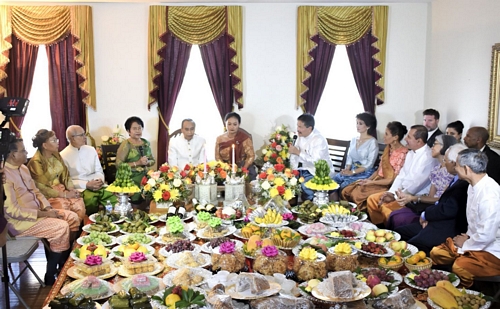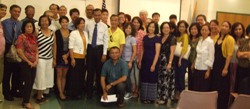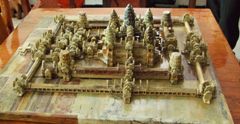Custom & Tradition
The word Khmer is referred to Cambodian people or the Cambodian language. The Khmer were influenced by Indian traders and scholars adapting their religions, sciences, and customs and languages. In the early days, they believe in Deva Raja (Hinduism God-King) and the great temple as a symbolic holy mountain.
In a typical Khmer family, the husband is the head of the family, responsible for providing shelter and food . The wife is generally in charge of the family budget and has considerable authority over family affairs. However, both men and women are responsible for working in the rice fields, and taking care of the household. Parents, children and grandparents are generally considered one household of extended nuclear families in Cambodia. Parents still have influence over their children, even while they are married and have children of their own. Overall, each family member shares the work in the household, which creates an efficient family dynamic.
In Cambodian society, men perform outdoor tasks. Traditionally among villagers, men are expected to do laborious works such as fishing, plowing rice field, threshing rice, making and repairing tools, and caring for cattle. Women generally handle housekeeping works such as keeping financial in order (keeping and managing what the husband earns), cooking, washing, mending, food shopping, childcare, and housecleaning. In urban areas, nowadays, both men and women are working, so there are shifts in traditional role. In the rural areas and during the rice cultivation season (July-September), men plow and prepare rice field and women predominantly plan rice. During harvest season (December-February), women harvest rice while men transport and crop rice grain from fields.
Cambodia is still a male-dominate society, even though, it has gradually changed in modern time. Since women perform housekeeping routines, they are in either inferior position or in a relative strength, depends on one sees it. The fact that women control family finances may not be regarded as a sign of superiority but represents real power in practical terms. However, women have much less access than men to the highest positions of political and economic power. They are often are victims of physical violence, verbal and psychological abuse.
Manners
Head is considered sacred part of the human body. Younger individual touches or plays the older one 's head is not acceptable. In the western world, it is considered a gesture of friendship and love. In Cambodia and even in the Europe or America, it is considered an insult or disrespect.
Traditional codes of behavior for women are more elaborate and strict than those for men. Man hugs woman, especially young unmarried woman, when greeting or seeing-off may be unacceptable to the elders. They prefer a traditional way which is bowing the head down with palm of both hands together around the chest pointing straight to the other party. Woman body is not to be touched by man even in such a friendly gesture. So use caution. Also, the elders, or even neighbors, construe them as having involving in a romantic relationship if men and woman are found alone together somewhere. It does carry stigma in the society if they do that repeatedly. In the modern day and in the urban areas, this behavior is more tolerable, but stricter in rural countries.
Man and woman living together without marriage is a stigma. They defame family reputation and the woman 's family seems to suffer the most. It is even worse if they carry child out of wedlock. If possible, parents of both sides will arrange the marriage to control the damage of their reputation.
Divorce is rare and when it happens, woman is often to blame without reasonable judgement. For this reason, some women endure suffering from a bad husband. Things have changed in modern time. But women are still suffering.
Unlike western custom, looking straight into the eyes when the young engages in a conversation with the old may be considered disrespect. In this situation, Cambodian prefers the young to bow down while talking. Cambodian people are shy. Even in a normal conversation among families and friends, they do not always look at each other. That depends on how close the relationship is. If you are an American or a foreigner, and you talk to them and they do not look at you, it does not necessarily mean they don 't like you. It is just the way the custom is.
Children are expected to obey and listen to their parents. Arguing with parents is rare in the Cambodian society. Children always do as the parent wishes; even sometimes they don 't like it. Parents are always right.
Cambodian expects guest to take off shoes and hat off. It is a matter of respect to the host. Hat off is also expected when entering a Buddhist temple or talking to the elders or Buddhist monk.
Food Offering to Ancestors
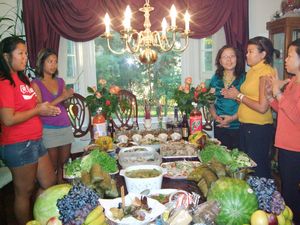
Cambodian believes in ancestors ' spirit. They often practice a ritual call "Sen Daun Ta" or simply "Sen" during which many kind foods are prepared an arranged in an orderly fashion at a dinning room/area. Pictures or ashes of the deceased are usually displayed. They use candle light and burned incent stick while praying. There is a designated leader conducting the praying services while all other family members stand around the table (or in Cambodia, they all sit down on the floor). There are three rounds of praying recital, often free-style and not scripted, in which they invite all those who have passed away (and they call them by name) to come and consume all the foods that they have prepared by their own hand. In the pray, they also ask the ancestors to bless family members who are still alive for good health and prosperity and for a protection from evil. They pause about 4-5 minutes in between rounds. Each round they say the same pray. At the end of the third round, they pick a little bit food of each kind, put them into a dish, put a couple of burning incent stick on it, bring it to usually corner of the house outside and leave it there as a token of sending back ancestors to their own places, wherever it may be.
This ritual is done regularly during New Year and Pchum-Ben. It is a normal practice. However, there are occasions when they just want to do it as a sign that ancestors have not been forgotten. Some people do it because one of the family members gets sick and they believe "Sen" will result in a speedy recovery. Others do it because a sense of guilt of wrong doing and "Sen" is an apology to ancestors.
Parent Bathing
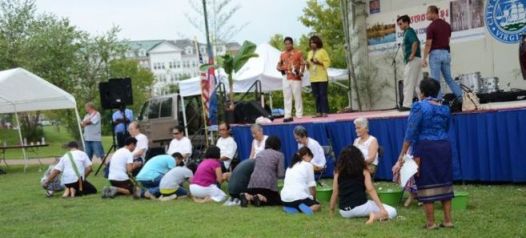
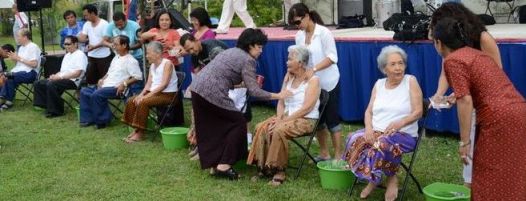
In Cambodian community, parents are highly respectable. They are the sources of our inspiration and guidance. We rarely challenge their authority. When they talk, we listen. We do as they wish and even if we do not like it, we usually negotiate with them in such a way not to upset them. We usually perform some rituals to appease them and to repay them gratitude. While good behavior and well-discipline are the normal course in Cambodian lives, most have gone far beyond ordinary affairs. Parent Bathing is one of the rituals that is enjoyed by both, parents and children. The ritual is normally performed in hot day mid-April at the Buddhist temple or at home, usually during the Cambodian New Year celebration. Parents are seated on a wooden bed (we will seat them on chairs in this event). The children get buckets of water, sanctified and blessed by Buddhist monks, and bath their parents with joy.
The Process of Cambodian Traditional Wedding
Overview
Wedding ceremony is a joyous event in any culture. For Cambodians living abroad, having the traditional ceremony requires understanding and preparation. In a modern society, life has caught up into many different things. Young Cambodians often ignore the significance of keeping their own culture. They tend to think it is their wedding and they have the right to do whatever they want. They are correct in a sense. Being home away from home, we just need to preserve our identity, our roots, our culture. For those who have decided to follow the Khmer tradition discover that their lives greatly enhanced with an intangible, untouchable feeling of satisfaction. They are always glad that they did the Khmer traditional wedding as part of their whole wedding plan. The benefit of having an everlasting memory in their life far outweighs the inconvenience of enduring a tedious process (changing clothes often, long sit-down on the floor, etc).
Khmer wedding is a long process in which many Cambodians have done or participated in the process. However, do they really understand each episode in the process? Khmer wedding music is so sentimental. To the ears of many, it sounds monotone and they cannot distinguish one from another. Do you know what song needs for what wedding episode? In the United States, the ceremony is shorten to fit the overall schedule. Doing a full-blown ritual would take all day or longer. Therefore, you need to select only a few episodes. Do you know what to select and do you understand the meaning of it? Khmer traditional wedding musicians are hard to find in the United States and elsewhere beside Cambodia. Therefore, you resort to playing pre-recorded songs as opposed to live music. To mimic the whole ceremony step-by-step without live music requires some understanding and preparation. And that is what the article is all about. The wedding guideline is tailored specifically for people who live the United States. It may differ from the practices in Cambodia or elsewhere. Traditionally, people sit on the floor. Offering and gifts are also arranged on the floor. Nowadays, it is not uncommon that participants are sitting on the chair and wedding stuffs are arranged on the table covered with beautiful table cloth.
Prelude
Khmer wedding is almost always performed at the bride 's residence. There is a respected person called Achar. He is normally very knowledgeable of Buddhism, who directs and mediates the whole ceremony. Although the event takes place at their residence, the bride 's family selects a representative called Meba, a married couple who are one of the closest friends of the bride 's parents. Similarly, the groom selects a representative call Chao Moha. The three groups of people are the officiants of the ceremony. Beside them, off course, elders, families and friends from both sides participate in the ritual.
The ceremony starts in the very early morning with a ritual of requesting ancestors to give them a right moment to start and to bless the participants, the house, tents, and all places where they conduct the ceremony. This episode is called Som Peelear (request a right moment). The music to play in this episode is called
| Homrong |
|
Other songs that may be played during the prelude session are:
| Sampong |
|
| Malop Dong |
|
| Chambak Rauy |
|
| Lomang Thnorng |
|
The Groom's Procession
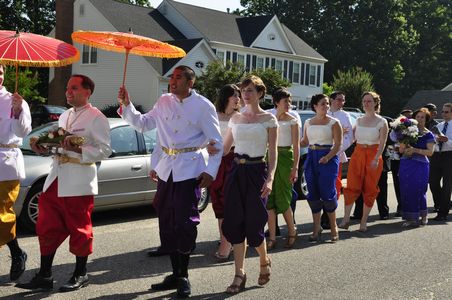
The groom 's procession re-enacts the Cambodian tradition based on legend and history. The procession symbolizes the trip of the first Khmer prince, Preah Thong, to the Naga Palace to ask King Naga 's permission to marry Princess Neang Neak. The prince was a foreigner exiled from his homeland, and during his travels he encountered and fell in love with the Naga Princess.
The procession is also a reflection of Cambodian social affairs. In the old days, marriage was arranged by parents. A man would ask his parents to go and request permission from the girl 's parents for a marriage. The man 's parents, family and friends would prepare a trip, bringing gifts and offerings to the girls ' residence. Parents on both sides had tremendous influence on the decision-making process in the courtship. This tradition has evolved to a more modern practice. It is quite common now that the man and woman have already fallen in love, and the wedding ceremony reaffirm their vow and to honor the tradition.
The music required for the groom processing episode is
| Chao Preahm |
|
The process is lead by a group of musicians followed by the Chao Moha, the groom and groom maids, then friends and families walking in two rows paired by a man and women, preferably husband and wife. Each pair carries a gift tray of same type. Gift may be fruit, cake, wine or beverages.
The procession ends at the door step of the bride 's residence. A make-shift gate may be built to use as an entrance to the bride 's residence. This is a place where Chao Moha meets Meba. Chao Moha tells Meba the purpose of the visit and asks Meba a permission to get into the house so that further dialog can take place inside. Meba agrees. Tradition may vary. Normally, the bride is nowhere to be seen. Occasionally another tradition is performed in which the bride comes down, meet and wash the feet of the groom.
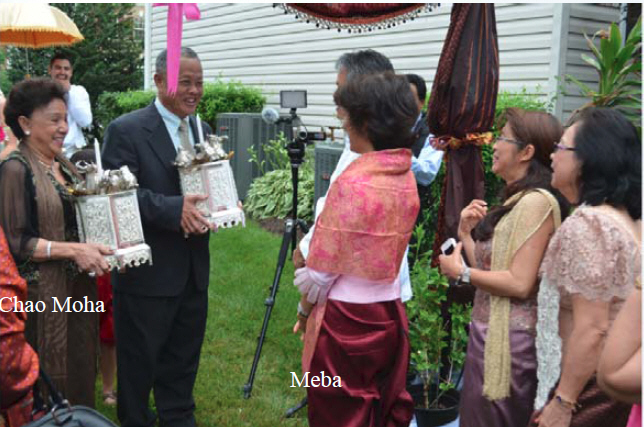
Elders Dialogue
This is a long ceremony that consists of many activities. It is a make-believe scene where the Meba (the representative of the bride) questions the purpose of the visit of Chao Moha (the representative of the groom) as if the bride and the groom never met each other before. They are negotiating the marriage process. At the end, they all agree, but not before they request to see the groom and the bride.
The Count-Fruits and Gifts Ritual
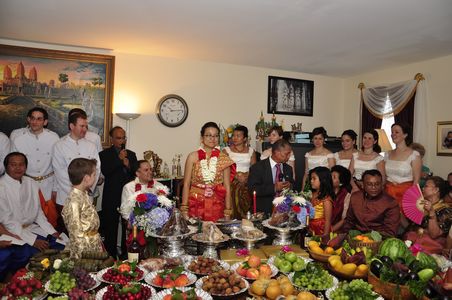 Now that they are inside, seated in that fashion and surrounded by friends and family, elders ' dialog begins. The bride and groom are not present at this time. The Chao Moho reiterates the purpose of their visit, that is, their son comes to ask permission to marry their daughter. Meba only agrees if Chao Moha brings many fruits, vegetables, flowers, cakes, and gifts. They need to verify by asking a pair of independent persons or just one person to count them in a dance-fashion while music is playing. Typically, there should be 36 kind of fruits of all sorts they can find and all kind of cakes and gifts. The count-fruit ritual is performed by the wedding musician group. If you do not have a live musician, you may want to ask friends or hire a man and a woman if possible, but only woman is fine, to perform the ritual. The music to play is
Now that they are inside, seated in that fashion and surrounded by friends and family, elders ' dialog begins. The bride and groom are not present at this time. The Chao Moho reiterates the purpose of their visit, that is, their son comes to ask permission to marry their daughter. Meba only agrees if Chao Moha brings many fruits, vegetables, flowers, cakes, and gifts. They need to verify by asking a pair of independent persons or just one person to count them in a dance-fashion while music is playing. Typically, there should be 36 kind of fruits of all sorts they can find and all kind of cakes and gifts. The count-fruit ritual is performed by the wedding musician group. If you do not have a live musician, you may want to ask friends or hire a man and a woman if possible, but only woman is fine, to perform the ritual. The music to play is| Rorb Phle Chheur |
|
Seating Arrangement
The family, friends, and guests are seated facing the Achar whose role is to facilitate the conversation. The groom 's family and friends are seated on one side, led by their representative, Chao Moha. The bride 's side is on the opposite site, led by their representative, the Mai Ba, The gifts and offerings are arranged in a matching pairs.
The Groom 's Appearance
This is an engagement acceptance ritual all over again. The groom appears first. The Mai Ba asks Chao Moha the purpose of their presence. A friendly dialogue begins. The Chao Moha states the purpose and introduces the groom to the bride 's family, friends, and guests. The Mai Ba consults with the bride 's family, checks the groom 's character, and asks groom to reaffirm his love for the bride. Live traditional wedding music is playing and a singer sings a lyric song that symbolizes a counting of all fruits and gifts brought by the groom. The Mai Ba customarily satisfies the counting and accepts all gifts.
The Bride 's Appearance
Since Mai Ba already agrees, the Chao Moha and their people have a right to ask for her presence with a blessing from the Achar. She appears and sits next to the groom. At this time, the Chao Moha and his people have their turn to verify the bride 's character and ask her to reaffirm her love for the groom.
The praying to ancestors
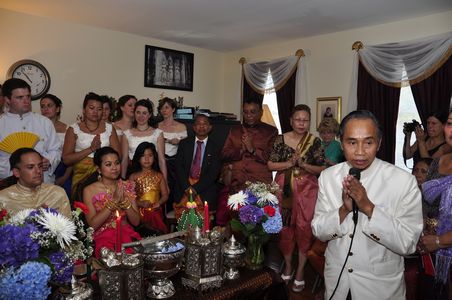
The ancestor spirits are believed to be caretakers of the living family. They reward the living with good health and prosperity in return for good behavior and obedience. Getting married without this declaration through this ritual is considered disobedient and may anger the spirits. They may cause sickness and bad luck to the couple or their immediate family.
Family bonds are the most important. A marriage is an inclusion of the couple into their new families. At all important events, family and friends are called upon to share in the celebration and offer their blessing. This ceremony calls forth for those who passed away to offer blessings and observe the wedding, if not in body, in spirit. It is time to reflect on those near and dear to our hearts and remember to include them in the happiness.
Achar leads an offering ceremony. The bride and the groom are sitting with each other in a kneel-down fashion. There are foods, drinks, lit candles and burning incense sticks. The smoke is believed to be an agent that carries the message to the spirit, and wakes them up so that they can witness the marriage. Family and friends are the spectators.
The music to play is called
| Kang Soy |
|
The hair-cutting ritual
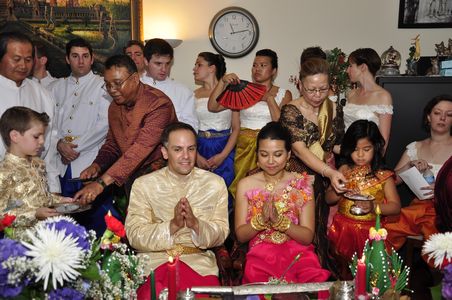
Before the bride and groom are officially married in the Khmer tradition, they must be prepared through an elaborate cleansing ceremony. In the old days, both bride and groom and their families were busy farming. Their hair grew long and their bodies were not clean.
Heavenly Scissors and Razors
The scissors, razors, comb, mirrors and perfume are sanctified and believed to be sent from heaven by gods. Likewise, a barber and a hair dresser are angels (Tevada) sent by Hindu gods from heaven. Cambodia practiced Hinduism before Buddhism. This so-called "the selling of scissors and razors" (even no actual selling/purchasing takes place) is an old belief that lingers up to present. In this ceremony, a couple (as Teveda) carrying scissors, razors, comb, mirrors and perfume dance as the music plays. Pretending they are lost, they stop and ask a spectator for a direction to the house of he most wealthy people in the area. The bride 's parents are given a wealthy status for one day regardless their actual status. So are the groom 's parents. The spectator gives a direct with a sense of humor as to make people laugh. Finally, the couple finds the wealthy couple, introduce themselves as angels sent by God Indra from heaven to bring them sanctified scissors and razors to use in the hair cutting ceremony. The wealthy couple accepts the gifts, give it to Achar. The music to play is
| Lok Kantray or Chap Deu Dei |
|
Hair-Cutting
The tradition may vary depending on the Achar 's discretion. In some instances, Tevada may be the first who cuts (all are pretending, no actual cutting) bride and groom 's hair while the wedding music (Sarika Keo) is playing. In another instance Achar may be the first or the bride 's parents are the first to start. Families and friends are lining up as couples taking turn to participate in the hair-cutting ceremony.
The essence of the hair-cutting ritual is the would-be pieces of hair from the cut are treated as bad luck hair. They throw them away to avoid misfortune that may have lingered. At the conclusion of the ceremony, Tevada returns to the realm of white candle, the home of gods and deceased ancestors. The music to play is called
| Sarika Keo |
|
This is a long ceremony, especially when there are many guests, friends and families to participate. When it is done, it usually follow by another song called
| Trapeang Peay |
|
That is, after hair cutting, they should take a bath.
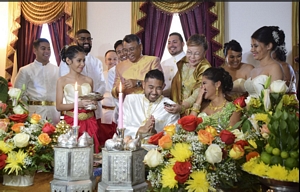
The honoring of parents
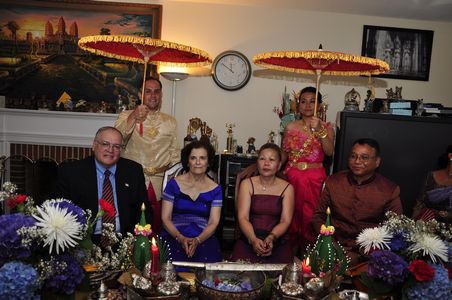
Honoring parents is an important aspect of Cambodian culture. "Honor your parents as you do to god" is a typical Cambodian sentiment that is rooted from the Buddhist teaching about not to forget parent 's gratitude called Kun - a kind act or good deed for which ones owes repayment (a debt of gratitude).
The ritual is led by Achar. The bride 's parent sit on the chairs (traditionally on the floor). The bride stands behind with an umbrella to shade them. The groom does the same to his parent. Customarily, a musician plays a solo fiddle and a singer sings a lyric song that describes the good deed and care the parent has given to them since the day they were born until this very day of their marriage. This ceremony is highly emotional that if the couple understands the lyrics, they may shed their tear. The song for the ceremony is
| Kat Khansla |
|
The Bok Leark ( Crushing Dyke) Ritual

This ritual stems from the fact that in the old days, most Cambodians are farmers who make their own clothes. Leak is a kind of fruit that can be made into dye which can be used to color clothing materials. Now that the bride and groom have
reached adulthood, are now married and raise their own family, they need to know how to make clothes and take care of their affairs of life. Dyke is also used to clean their teeth. Bok Leak is a demonstration of how to grind or smash fruit of dyke, Leak. There are four young girls all must be virgin dressed in a very nice Cambodian outfit. They may or may not team with other four young boys. Each of the performer holds a long and big stick up and down crushing fruits of dyke that are placed in one or two woodmortars depending on how many dancers. The bride and groom are standing behind watching as if they are learning the process. There are two parts in performance: the first part is a journey to pick dyke, the music is Om Touk; the second part the crushing dyke and the music is Bok Leak. This ritual is mostly forgotten. Nobody has done this in America. The Royal University of Fine Arts in Cambodia has made this tradition into a folklore dancers. They have added some variations to the original idea to preserve the tradition.
Bok Leak song for wedding
Bok Leak song for dance
The Beuk Veangnorn ( the Open Curtain) Ritual
Rorm Beuk Veangnorn
This is a prelude to a Phtim (Match-Up) ritual, the first of the two episodes. The bride is now in hiding behind the curtain. Achar, Meba and Chao Moha are preparing a match-up ceremony and they need both bride and groom to appear. The groom appears first with the sound of gong . The music Sdach Yeang (the king is coming)
But the bride won't come out until the groom is begging her. A performer plays a role as the groom, dancing and singing to say please open the curtain and come out. Song: An Euy Srey An
Dork Dav (Sword-Drawing) ceremony
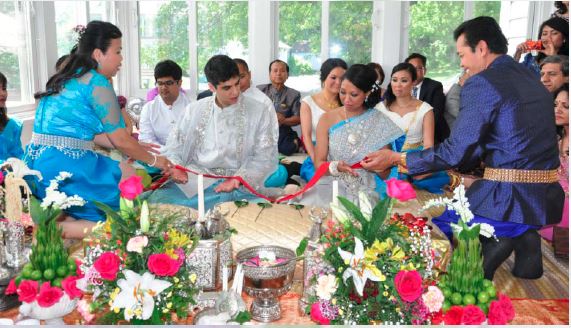
The bride has come out now and sits next to the groom. The Dork Dav, sometimes called Haut Dav is a blessing ritual to the bride and groom. Dav (sword) is sanctified and is sent to earth for the groom (Preah Thong) to protect his wife-to-be. Two performers (male and female) dance and sing the blessing lyric song, Nokoreach or Dork Dav
The passing of blessings (the Bangvel Porpil) Ritual
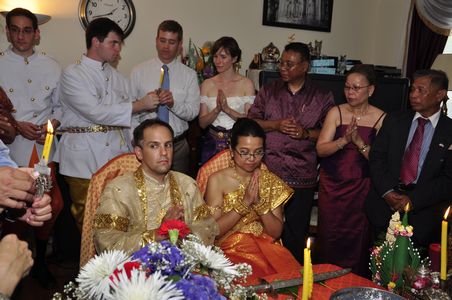
This is another prelude to the Phtim (match-up) ritual. In this ceremony, only married couples are allowed to participate as it is believed that they will pass along the special quality or essence which has preserved their union. They are asked to sit in a circle around the bride and groom. Three candles are lit and passed from person to person. Each participant passes his or her right hand over flame in a sweeping motion toward the couple, sending or throwing the candle incense as a silence blessing on them. Achar recites a special prayer. The candles are passed around the circle clockwise seven times to complete the ceremony. At the conclusion, Achar blessed them and may give them advice.
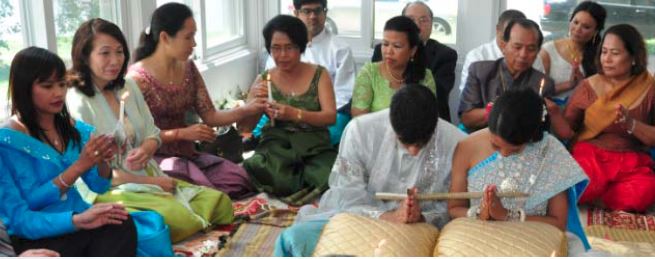
The Phtim ( match-up) Ritual
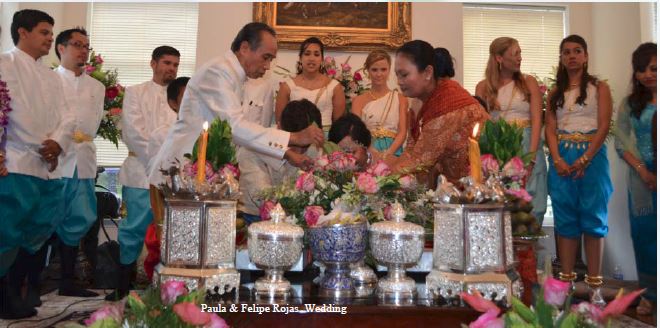
After the Bangvel Porpil, Achar performs a series of blessing, giving advise to the young couples.
The five advising virtues to the husband:
- You shall honor and praise your wife
- You shall not look down on your wife
- You shall be honest to and not cheat on your wife
- You shall give your wife a full discretion on household affairs
- You shall beautify your wife with jewelry
The five advising virtues to the wife:
- You shall take good care of your husband and household affairs
- You shall treat your husband's family as if it is your own
- You shall be honest to and not cheat on your husband
- You shall manage your husband's earning proficiently
- You shall not be lazy and careless
The knot-tying ceremony
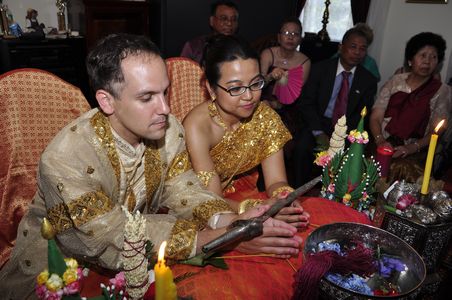
Cambodian weddings traditionally have a knot-tying ceremony. Unlike what the name implies, it is the guests who tie the knots. Parent of both bride and groom start the ceremony, followed by close family and friends. They give best wishes and blessings to the new couple while they tie ribbons around each of their bride and groom 's wrists. They were traditionally required to wear them for three days afterwards to the preserve the good luck. The ceremony is concluded with special recitations from the Achar and blessings from family and friends. Song used in the ceremony is Bay Khon Chang Dai
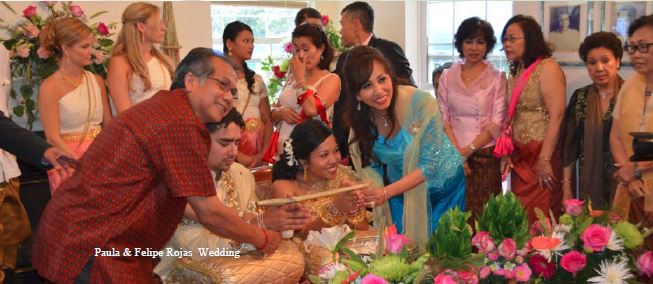
The throwing of phka-sla
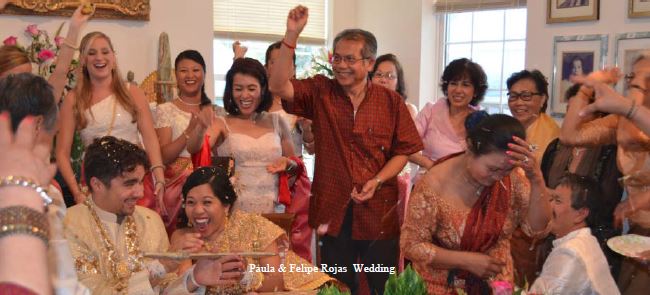
Phka-sla is a palm tree flower symbolizing the power of blessings. The throwing of Phka-sla concludes the wedding ceremony with jubilation and excitement. The new couple is now officially married. The new couple are led to the room, prepared especially for the honeymoon ceremony where the husband and wife peel bananas and other fruits, and feed each other while friends stand by to watch and applaud. Friends will tease them with every move the couple makes. Song used in the ceremony is Chauk Chey Serey Mangkul
The Preah Thong Taung Sbai Ritual
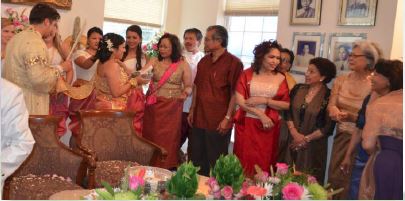
Before the young couple are led to the room, a ceremony is performed to conclude the wedding process. The wife (Neang Neak) is leading her husband (Preah Thong). They walk around the altar or table of wedding items three times. The
husband is holding onto his wife outer garment while walking. The music that is played is Preah Thong Taung Sbai
The Banh Chok Chek Ritual
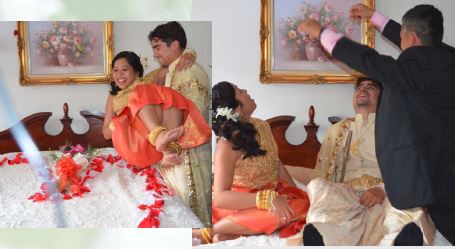
The young couple is led to the room. Inside the room, close friends and families await the arrival of the young married couple. The bed is decorated with flowers. The door is closed. The light is off. When the couple opens the door, they all explode into laughter. The music, Laum Neang, starts playing.
Reception
The traditional wedding ceremony is followed by a warm, hearty reception where authentic Cambodian food is served.
Kathen (or Kathina Celebration)
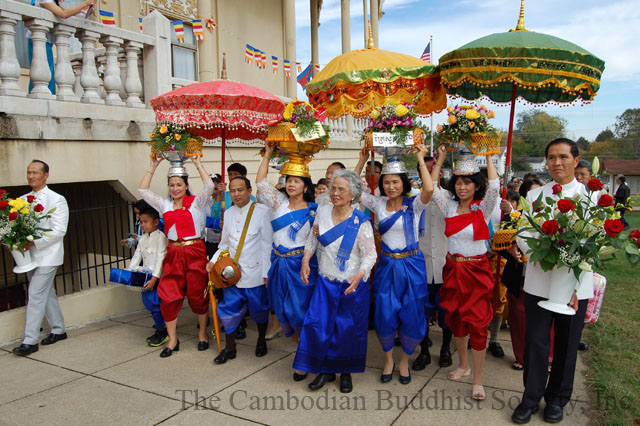
Kathen is a Buddhist ceremony, a festive that marks the end of monk-stay-in season (during the rainy season). The monks during that period cannot travel a far. Only when it is necessary because a parishioner invites them to perform a certain Buddhist ceremony, monks must stay in the temple and perfect their reciting of dharma. If they must be out of the pagoda, they must return to the premise before sunset. Kathen festival is marked by trio gifts called Trai. There are three gift packages consist of monk cloth, dried and non-perishable food (condensed milk, tea, cookie, cracker, etc) and offering items that will be offered to the monks. Each gift package is sponsored by an individual or a group of people. Everybody else can join the festival and make donation. But those who pledge the trio gifts have a privilege of leading the parade (people under the big umbrella) after the religious ceremony. Usually, the parishioners of one temple bring the Kathen to another temple of their choice. Each temple must do one Kathen in a year. But a parishioner can go to as many Kathen as they can make it. People believe that if they can attend 7 Kathen in a Kathen season, they are granteed a path to heaven after they die.
Pchum-Ben
Pchun-Ben is similar to Thanksgiving in USA. It is a Buddhist festival that Cambodian use to pray and make a food offering to the ancestors, the relatives that already passed.
